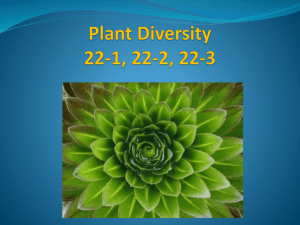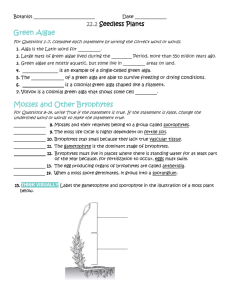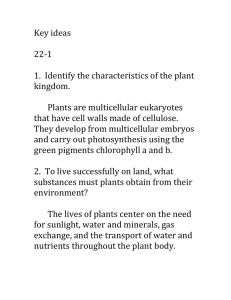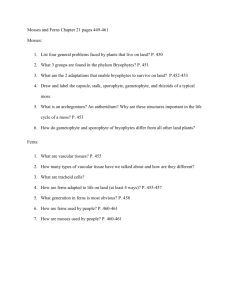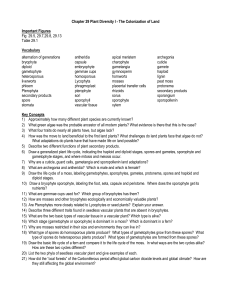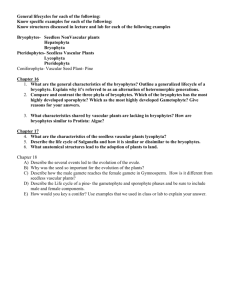22-2 PowerPoint Notes
advertisement
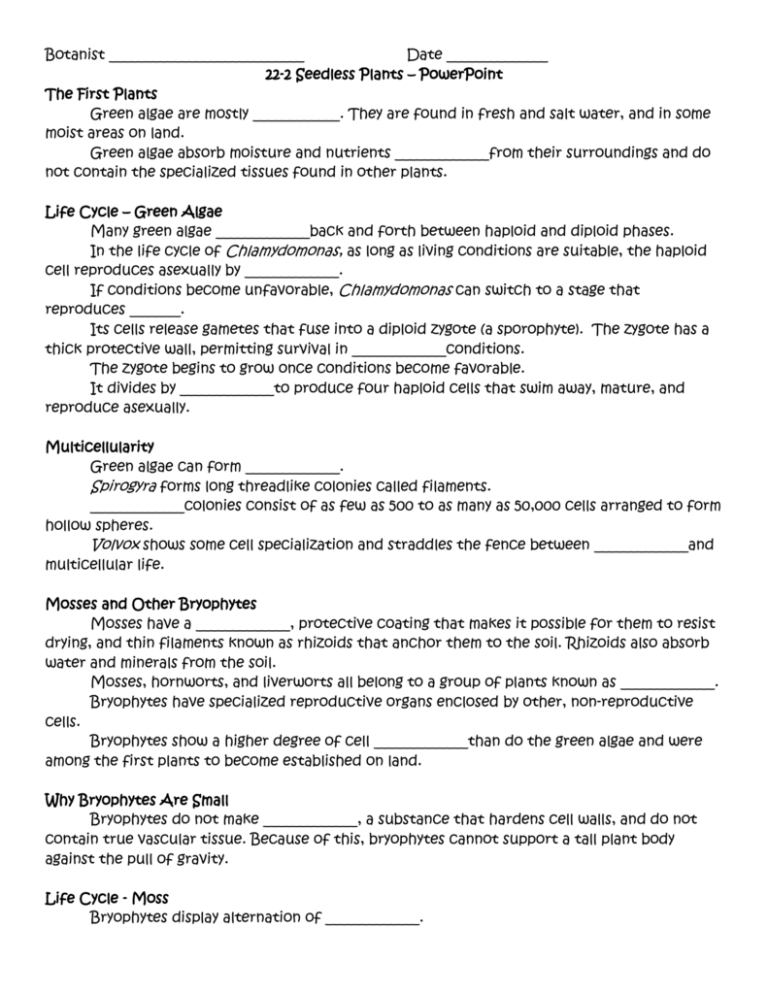
Botanist ___________________________ Date ______________ 22-2 Seedless Plants – PowerPoint The First Plants Green algae are mostly ____________. They are found in fresh and salt water, and in some moist areas on land. Green algae absorb moisture and nutrients _____________from their surroundings and do not contain the specialized tissues found in other plants. Life Cycle – Green Algae Many green algae _____________back and forth between haploid and diploid phases. In the life cycle of Chlamydomonas, as long as living conditions are suitable, the haploid cell reproduces asexually by _____________. If conditions become unfavorable, Chlamydomonas can switch to a stage that reproduces _______. Its cells release gametes that fuse into a diploid zygote (a sporophyte). The zygote has a thick protective wall, permitting survival in _____________conditions. The zygote begins to grow once conditions become favorable. It divides by _____________to produce four haploid cells that swim away, mature, and reproduce asexually. Multicellularity Green algae can form _____________. Spirogyra forms long threadlike colonies called filaments. _____________colonies consist of as few as 500 to as many as 50,000 cells arranged to form hollow spheres. Volvox shows some cell specialization and straddles the fence between _____________and multicellular life. Mosses and Other Bryophytes Mosses have a _____________, protective coating that makes it possible for them to resist drying, and thin filaments known as rhizoids that anchor them to the soil. Rhizoids also absorb water and minerals from the soil. Mosses, hornworts, and liverworts all belong to a group of plants known as _____________. Bryophytes have specialized reproductive organs enclosed by other, non-reproductive cells. Bryophytes show a higher degree of cell _____________than do the green algae and were among the first plants to become established on land. Why Bryophytes Are Small Bryophytes do not make _____________, a substance that hardens cell walls, and do not contain true vascular tissue. Because of this, bryophytes cannot support a tall plant body against the pull of gravity. Life Cycle - Moss Bryophytes display alternation of _____________. The _____________is the dominant, recognizable stage of the life cycle and the stage that carries out most of the photosynthesis. The _____________is dependent on the gametophyte for its supply of water and nutrients. Bryophytes produce sperm cells that swim using _____________. For fertilization to occur, the _____________must swim to an egg. Because of this, bryophytes must live in habitats where open water is available at least part of the year. Gametophyte When a moss spore lands in a moist place, it sprouts and grows into a young gametophyte. The gametophyte forms rhizoids that grow into the ground and shoots that grow into the air. Gametes are formed in reproductive structures at the tips of the _____________. Eggs are produced in _____________. Sperm are produced in _____________. Sperm and egg cells fuse to produce a diploid _____________. Sporophyte The _____________marks the beginning of the sporophyte stage of the life cycle. A sporophyte grows within the body of the gametophyte, depending on it for water and nutrients. Eventually the sporophyte grows out of the gametophyte and develops a long stalk ending in a capsule called the _____________. Haploid _____________are produced inside the capsule by meiosis and are released when the capsule ripens and opens. Vascular Plants About ____ million years ago, plants for the first time were able to grow high above the ground. Fossil evidence shows these plants were the first to have a transport system with true vascular tissue. Vascular tissue carries _____________and nutrients much more efficiently than does any tissue found in bryophytes. Evolution of a Transport System Vascular plants are known as tracheophytes, after a specialized type of water-conducting cell they contain. These cells, called _____________, are hollow tubelike cells with thick cell walls strengthened by lignin. Tracheids are found in _____________, a tissue that carries water upward from the roots to every part of a plant. They also have a second transport tissue called _____________that transports solutions of nutrients and carbohydrates produced by photosynthesis. Seedless Vascular Plants Among the seedless vascular plants alive today are three phyla commonly known as club mosses, horsetails, and ferns. The most numerous of these are the _____________. Life Cycle – Fern In the life cycle of a fern, spores produced by the sporophyte grow into thin, heartshaped haploid gametophytes. The gametophytes _____________ independently of the sporophyte. Sperm and eggs are produced on the gametophytes in antheridia and archegonia. Fertilization requires at least a thin film of water, so that the _________ can swim to the eggs. The diploid zygote produced by fertilization develops into a new sporophyte plant. This is the _____________stage of the fern life cycle. Haploid spores develop on the undersides of the fronds in sporangia, and the cycle begins again.
